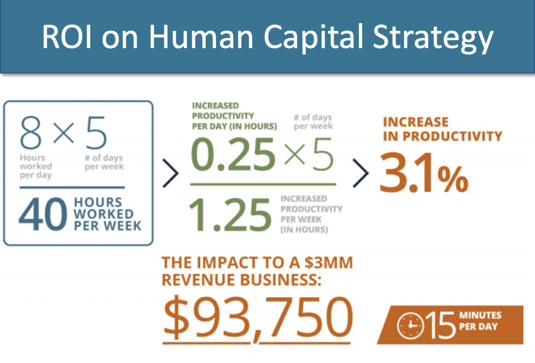
Workplace burnout has officially been recognized as a medical diagnosis by the World Health Organization. Described as “a syndrome conceptualized as resulting from chronic workplace stress that has not been successfully managed,” this may not come as a surprise to anyone who has experienced burnout first handedly.
The old adage rings true: “work smarter, not harder.”
Burnout decreases productivity, and causes employees to no longer work efficiently. As a result, they are not working to their full potential and are falling short on outputs. No one wins.
Beyond the physical well being of employees, workplace burnout negatively impacts an organization's output.
“The impact of employee burnout reaches other team members, your business and your customers.”
How do you keep employees engaged without inducing burnout? According to a recent study, 1 in 5 highly engaged employees is at risk for burnout.
What Does Workplace Burnout Look Like?
Workplace burnout can take many shapes overall. The World Health Organization states the following three defining characteristics of burnout:
- Feelings of energy depletion or exhaustion
- Increased mental distance from one’s job or feelings of negativism or cynicism related to one's job
- Reduced professional efficacy
Bigger Picture: Human Capital Strategy
Your employees are your most valued resource. A burnout will reduce professional efficiency.
The impact of how people drive profits cannot be underestimated. The American Institute of CPAs estimates that 68 percent of the value in a company is derived from its employees. Margins, productivity, profits and cash flow can be impacted in many ways.
Reducing employee burnout will result in a more productive working environment. Increasing productivity means improved cash flow and increased profitability.
For example, let’s look at the revenue impact of improving an employee’s productivity by just 15 minutes a day...
In a typical 40-hour work week, 15 minutes of non-productive, non-billable time equals .25 hours a day, 1.25 hours a week, or 65 total hours a year. For a $3 million business, an increase of productivity of that magnitude translates to more than $93,000 annually.
5 Tips To Avoid (or at least Minimize) Employee Burnout
Here are a few simple steps to take to set your employees up for success and beat the burnout...
1. Support Vacations
The majority of U.S employees don't use all of their vacation days -- and they're feeling the price of it. According to the US Travel Association 52% of Americans reported they didn't use all of their vacations.
Run a report every year of your employee vacation hours to make sure there aren’t any excessive hours. Time off work can provide a big boost to an employee's productivity, creativity, and overall job satisfaction.
2. Allow Remote Work
Environment plays a large factor in the productivity and motivation of employees. Creating a flexible work environment helps eliminate the possibility of getting stuck in a rut. Having the opportunity to occasionally work remotely allows employees to think at their own pace. A day of productive solitude allows everyone to take a break from the office bustle.
Use this guide to help manage remote employees. We put together the best practices from our IT team in creating and managing a productive (and secure) remote work environment.
3. Track Time
As a CEO, it's important to draw the line between work and home for your employees. If employees work from home, don’t allow them to work off hours. Of course there will be times when it’s necessary to work late, but it’s important to keep a consistent work schedule.
One way to do this is to make sure they are tracking their time and focusing on where they are spending their hours. Far too often, workers fail to realize the value of their time. Making sure employees are balancing professional time with personal time is mandatory to sustain long-term happiness. If staff members are staying late in the office every night, they aren’t working efficiently throughout the day.
Look for time tracking and scheduling software that's easy to use and integrates well with accounting and other operational software. At GrowthForce, we specialize in QuickBooks accounting systems. We recommend TSheets as a great add-on option.
4. Encourage Staff To Take Breaks Every 90 Minutes
Encourage staff members to take short breaks throughout the day,
According to the 2019 Workplace Productivity Report, 87% of office professionals spend an average of seven hours a day staring at a digital screen.
Taking regular breaks will lead to a more productive work day and a higher level of focus. Whether it be a coffee break or team walks, encourage employees to step back from their computer screens and recharge.
5. Setting Expectations
Studies have found perfectionism and burnout could sometimes go hand in hand. Setting clear and realistic expectations with employees will guide them on where they should be spending their time, making sure they stay on the right track.
Communicating expectations properly is the key component. Have managers sit down with their employees to clearly define expectations and goals. According to Roots Through Recovery's website, communication is the key to good mental health and is a crucial step in preventing burnout. If you have employees who are struggling with their mental health, it’s important that they know they can talk to someone about it. They should feel like they have a support network available to them at all times.
Most importantly, make sure it's in writing. According to a landmark Harvard study, setting goals and writing down your objectives enhances motivation and increases your likelihood of success.
Companies that had written objectives showed a 700% increase in growth versus those that didn’t.
Bottom Line
As the "new-normal" sets in and we begin to venture back into the office, it's important to prioritize the well-being of employees- both mentally and physically. This guide helps support working adults as they transition back to in-office work.
A strategic CEO recognizes people drive performance and, as a result, achieves significantly better business outcomes. If you have a great culture, you will have high-performing teams. A human capital management strategy and a financial management strategy go hand in hand.

.png?width=563&height=144&name=New%20GF%20Logo%20(37).png)


